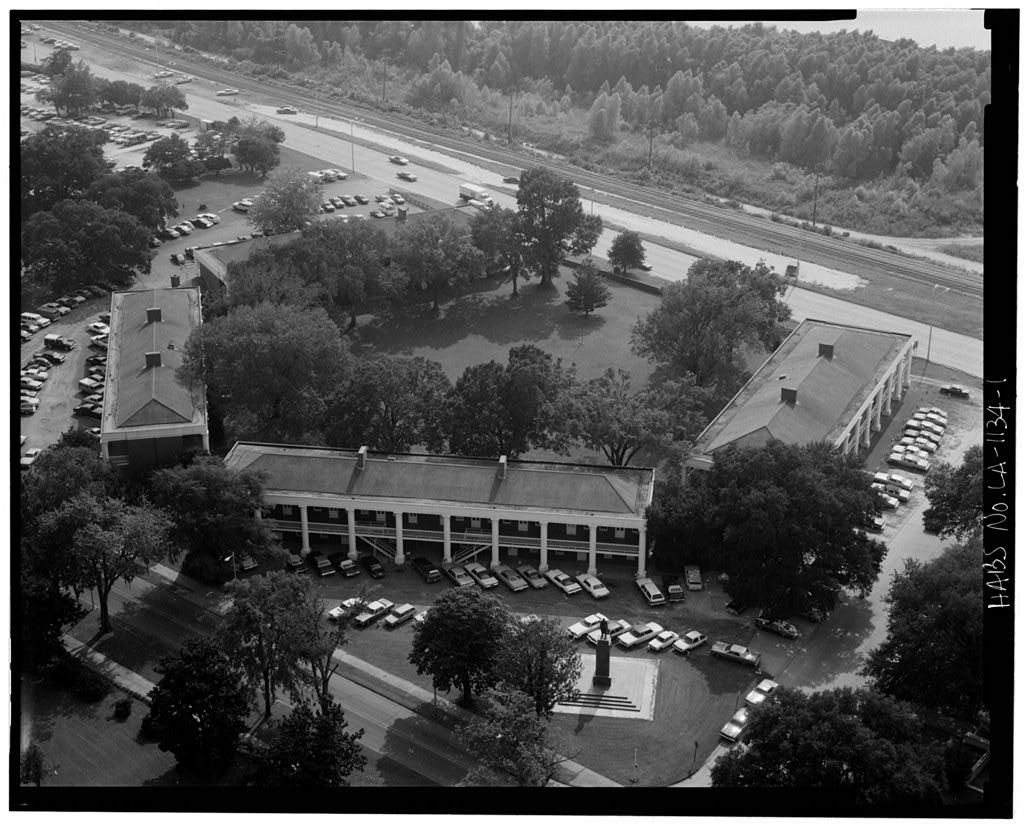- Pentagon Barracks
Infobox_nrhp | name =Pentagon Barracks
nrhp_type =
caption =
location= North Riverside Mall,Baton Rouge, Louisiana
lat_degrees = 30
lat_minutes = 27
lat_seconds = 19
lat_direction = N
long_degrees = 91
long_minutes = 11
long_seconds = 20
long_direction = W
locmapin = Louisiana
area =
built =1819
architect= Gadsden,Capt. James; Hill,John
architecture= No Style Listed
added =July 26 ,1973 cite web|url=http://www.nr.nps.gov/|title=National Register Information System|date=2008-04-15|work=National Register of Historic Places|publisher=National Park Service]
governing_body = State
refnum=73000863Infobox Historic building
name=The Pentagon Barracks
caption=U.S. Barracks, Riverside Mall, Capitol Avenue, Front Street, Spanish Town, Baton Rouge, East Baton Rouge Parish, LA
map_type=
latitude= 30.4555
longitude=-91.1894
location_town=Baton Rouge, Louisiana
location_country=flag|USA
architect=
client=
engineer=
construction_start_date=
completion_date=1825
date_demolished=
cost=
structural_system=
style=
size=The Pentagon Barracks are a complex of buildings located at State Capitol Drive at River Road inBaton Rouge, Louisiana on the grounds of the state capitol. The site has been used by the Spanish, French, British,Confederate States Army , andUnited States Army and was part of the short-livedRepublic of West Florida . [ cite web|url=http://www.nps.gov/history/nr/travel/louisiana/pen.htm |title=Pentagon Barracks |accessdate=2008-08-12 |work=National Register of Historic Places |publisher=National Park Service ] During its use as a military post the site has been visited by such notable figures asLafayette ,Robert E. Lee ,George Custer ,Jefferson Davis andAbraham Lincoln .French, British and Spanish Fort
The area around what is now Baton Rouge was discovered by
Pierre Le Moyne d'Iberville around 1700. It remained in French hands until the British took control of the city in 1763. cite web|url=http://house.louisiana.gov/pubinfo/Virtual%20Tour/pentagon_barracks.htm |title=Pentagon Barracks |accessdate=2008-08-12 |work=Louisiana Capitol History and Tour ]In 1779, during the
American Revolution , the British erected a dirt fort on the banks of theMississippi River on the site of what is now the Pentagon Barracks. The site was then called Ft. Richmond.However, the fort wasoon captured by the Spanish Governor of Louisiana,
Bernardo de Galvez during the Battle of Baton Rouge which was fought betweenSeptember 20 andSeptember 21 ,1779 . Gálvez arrived at Baton Rouge onSeptember 20 and found the town fortified and the fort garrisoned by over 300 troops. Gálvez' engineers constructed a siege line which enabled the Spanish to shell the fort and force a British surrender the next day. The Spanish renamed the garrison Ft. San Carlos.Republic of West Florida
American and remaining British settlers in Louisiana resisted Spanish control rebelled in 1810 to establish the Republic of West Florida. The "
Bonnie Blue Flag " of the Republic of West Florida was raised over the fort for the short 90 day life of the Republic. The city of Baton Rouge was turned over to the United States on December 10, 1810.United States Military post
The Pentagon Barracks served as the assembly point for American troops going to the
Creek War in 1813-1814 and to theBattle of New Orleans in 1814-15. The post was expanded between 1819 and 1823 when new barracks were built and a large Arsenal Depot was established to serve the southwestern United States.The two-story brick buildings that form four sides of the pentagon were built in 1825 after six years of planning. U.S. Army Captain
James Gadsden designed the barracks and was also in charge of the construction. A fifth combination commissary/warehouse building was also constructed, but was torn down within a few months due to poor construction. The new complex was known as the Baton Rouge Arsenal and Ordnance Depot.The fort remained an U.S. military post until 1861 when it was seized by the State of Louisiana, who turned the operation of the arsenal over to the
Confederacy . The fort remained in the hands of the Confederacy until Baton Rouge was evacuated in April 1862, during the Battle of New Orleans. The attempt by the Confederates to retake Baton Rouge in August 1862 was unsuccessful (see theBattle of Baton Rouge (1862) ). The Pentagon Barracks was renamed Fort Williams after Union General Thomas Williams who was killed in the battle.Louisiana State University
In 1884, the General Assembly of Louisiana passed a resolution allocating the full usage of the buildings and grounds of the Pentagon Barracks to
Louisiana State University . The University gained full possession of the grounds in 1886 and remained there until moving to the current location of the campus in 1926.Modern use
In 1951, ownership of the Barracks was transferred to the State of Louisiana and in 1976, it was placed on the National Historic Register..
The Pentagon Barracks now houses the offices of the lieutenant governor, the Pentagon Barracks Museum and Visitors Center, and private apartments for state legislators.
ee also
*
History of Louisiana References
External links
* [http://house.louisiana.gov/pubinfo/virtual%20tour/pentagon_barracks.htm Capitol Complex attractions]
* [http://www.sos.louisiana.gov/archives/LRTA/lrta-c.htm Historic Photos]
* [http://www.nps.gov/history/nr/travel/louisiana/pen.htm Pentagon Barracks] , at National Park Service
Wikimedia Foundation. 2010.
